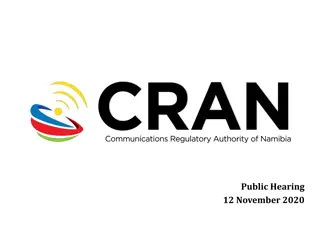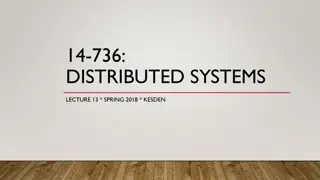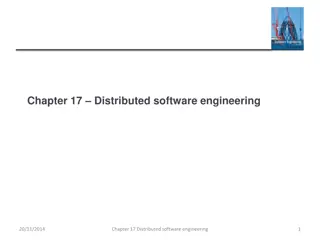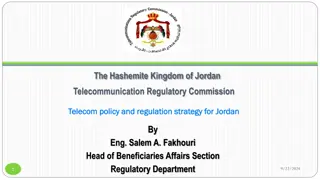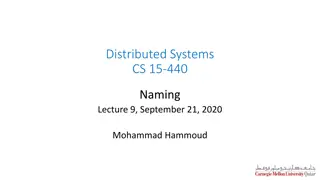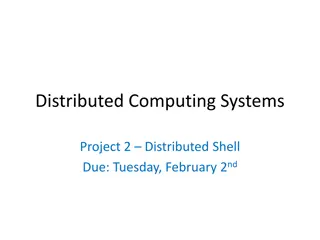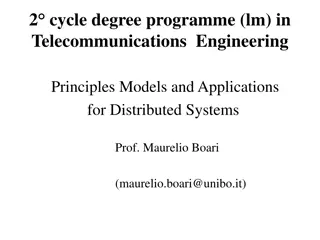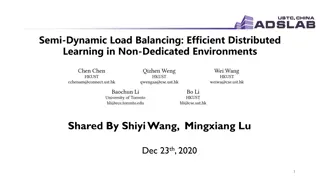
Telecommunications Engineering Principles: Distributed Systems & Technologies
Knowledge in managing computer networks and distributed systems, centralized vs. distributed systems, advancements in technology, and benefits of distributed systems over centralized ones.
Uploaded on | 1 Views
Download Presentation

Please find below an Image/Link to download the presentation.
The content on the website is provided AS IS for your information and personal use only. It may not be sold, licensed, or shared on other websites without obtaining consent from the author. If you encounter any issues during the download, it is possible that the publisher has removed the file from their server.
You are allowed to download the files provided on this website for personal or commercial use, subject to the condition that they are used lawfully. All files are the property of their respective owners.
The content on the website is provided AS IS for your information and personal use only. It may not be sold, licensed, or shared on other websites without obtaining consent from the author.
E N D
Presentation Transcript
Cellular IoT Devices (NB-IoT, LTE-M) 3GPP 4G/5G Network COMMAND COMMAND COMMAND COMMAND COMMAND COMMAND Apps COMMAND COMMAND IoT Features IoT Features DATA DATA DATA DATA DATA DATA DATA IoT Server
Increasing numbers of cellular IoT devices are starting to hit the market E.g.- NB-IoT, LTE-M and higher category devices supporting functions such as video surveillance 3GPP has been adding several IoT centric features to their standard starting in Release 10 (2011) all the way through their latest Release 15 (2018) Features to avoid network congestion resulting from massive numbers of IoT devices such that operators can continue to provide a high quality of service to all their subscribers Features to enable more efficient use of network resources by IoT devices such that an operator can minimize network deployment and management costs Features to help keep an operator s network secure from the increased threats of IoT devices Features that allow IoT devices to sleep for long periods of time such that they can maximize their battery lives Many operators have been adding support for these 3GPP IoT features to their networks
For IoT devices and apps to use many of these 3GPP IoT features, it requires detailed and low-level knowledge of 3GPP and in some cases a close business relationship with the network operator E.g. Configuration of IoT device sleep times requires intimate knowledge of 3GPP PSM and eDRX functionality This presents a high barrier of use and adoption by typical IoT device manufacturers and app developers 3GPP IoT features provide some lower-level enabling functionality rather than complete ready-to-use end-to-end solutions for IoT devices and apps IoT devices and apps are left to how best to piece together and use these functions together with one another If devices and apps do not properly use these features, cellular IoT deployments will fail Inefficient use of network resources will result in higher costs and less scalability for operators Shortened battery life of devices will result in the inability to deploy cellular IoT technology in many IoT use cases Security of the network, devices and applications will be compromised
Service Layer Cellular IoT Devices (NB-IoT, LTE-M) 3GPP Core Network Apps SCEF (4G) / NEF (5G) T8 IoT Features SGi IoT Server oneM2M Rel-3 is the first IoT service layer standard to interwork with 3GPP Core Network IoT features oneM2M Service Layer provides a complimentary set of value-add services over top of 3GPP IoT features oneM2M eases the use and helps increase adoption of 3GPP IoT features by IoT devices and apps oneM2M interacts with a 3GPP operator s network to mitigate congestion, enable efficient use of network resources, and helps keep network secure oneM2M can be deployed internal (or external) to an operator s network and enable an operator to move up the value-chain to offer not just connectivity but also additional value-add IoT services
IoT Device Enrollment IoT Device Sleep Schedule Management It is not trivial to get unmanned cellular IoT devices enrolled onto a operators network. oneM2M Service Layer optimizes the sleep schedule of cellular IoT devices such that battery life can be maximized. This can be done based on the schedule requirements of IoT devices and the apps that interact with the devices and the requirements of the cellular network operator. oneM2M Service Layer initiates the triggering of cellular IoT devices to connect to an operator s network, be bootstrapped with proper security credentials and authenticate and securely register. IoT Roaming Device Services IoT Device Location Tracking IoT apps can make requests that target a roaming cellular IoT device. Many cellular IoT devices lack location reporting capability oneM2M Service Layer receives 3GPP notifications that device is roaming, buffers requests targeting the roaming device and then forwards the requests when device is no longer roaming. This can be a valuable service for certain IoT use cases. oneM2M Service Layer supports tracking current location and storing past locations of a device via use of 3GPP location services and generating notifications to IoT apps.
Manage Data Delivery Methods Network Congestion Control Cellular IoT devices may support different application data delivery methods over a 3GPP network such as delivery over IP or non-IP. A particular region of an operator s network may become congested. oneM2M Service Layer receives 3GPP notifications that network is congested and throttles or buffers requests targeting IoT devices in that region based on priority until congestion resides. oneM2M Service Layer manages the method of data delivery used for a device based on schedule and priority of requests. IoT Device Tampering Network Communication Pattern Configuration Unmanned cellular IoT devices are more susceptible to tampering. oneM2M Service Layer provides operator networks with anticipated communication patterns of IoT devices based on input from IoT apps. oneM2M Service Layer receives 3GPP notifications that device has been tampered with and blocks IoT apps from sending/receiving new requests to/from device or accessing stored data from the device which may have been compromised. Operators use this information to proactively manage their network resources
Wake a Sleeping Device Group-Based Communication Apps can make requests that target a sleeping cellular IoT device. Many IoT use cases call for communicating with a group of devices (e.g. update firmware on devices) oneM2M Service Layer keeps track if device is sleeping and sends it a trigger to wake it up and process requests from apps if needed. oneM2M Service Layer supports establishing and tearing down groups of devices and fanning out requests to a group using 3GPP multicast/broadcast feature. Background Data Transfer Network operators can offer time windows during off peak hours that have cheaper message delivery costs. oneM2M provides APIs to IoT devices and apps that interwork to 3GPP background data transfer feature
oneM2M Service Layer buffers request until device exits power savings mode and oneM2M Service Layer sends buffered requests to device that is reachable becomes reachable A Cellular IoT Device enters power savings mode Cellular IoT Device receives request (PSM/eDRX) to conserve its battery 3GPP CN notifies oneM2M Service Layer device has exited power 3GPP CN notifies oneM2M Service Layer device has entered power savings mode savings mode A oneM2M App issues a request targeting an IoT device REQ REQ Service Layer Cellular IoT Devices (NB-IoT, LTE-M) REQ REQ 3GPP Core Network Trigger Apps REQ Trigger T8 Trigger IoT Features SCEF IoT Server oneM2M Service Layer subscribes to 3GPP CN to receive notifications when a Cellular IoT device enters or exits power savings mode oneM2M Service Layer can send a trigger request to a device to have it re-connect as soon as possible (e.g. for high priority requests). Cellular IoT Device receives trigger and reconnects to network
oneM2M plans to continue to add more value-added services over top of 3GPP Core Network IoT features in its next release (Rel-4) Configuring QoS levels of requests flowing over a 3GPP network based on application specific requirements Sponsoring traffic flows over a 3GPP network between IoT devices and apps (e.g. IoT Service Provider can sponsor and pay for traffic flows) Interworking with 3GPP s V2X APIs
oneM2M Rel-3 interworks with 3GPP Core Network IoT features oneM2M provides a complimentary set of value-add services over top of 3GPP IoT features oneM2M eases the use and helps increase adoption of 3GPP IoT features by IoT devices and apps oneM2M interacts with a 3GPP operator s network to mitigate congestion, enable efficient use of network resources, and help keep network secure oneM2M can be deployed internal (or external) to an operator s network and enable an operator to move up the value-chain to offer not just connectivity but also additional value-add IoT services oneM2M plans to continue to add more value-added services over top of 3GPP Core Network IoT features in its next release (Rel-4)





